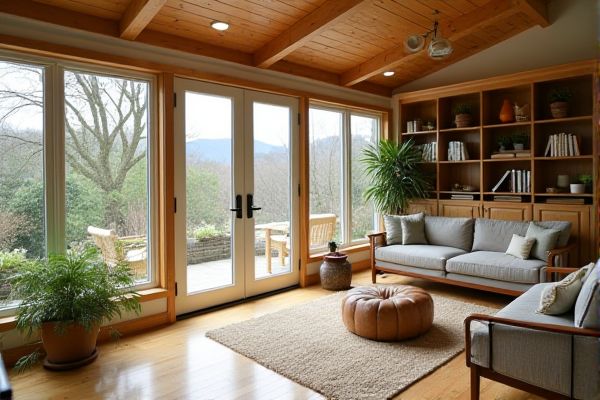
Vertical storage in a sunroom maximizes space by utilizing wall height for shelves or cabinets, making it ideal for small areas or limited floor space. Exploring the advantages and considerations of vertical versus horizontal storage will help you choose the best option for your sunroom; read on to discover which storage style fits your needs.
Table of Comparison
| Feature | Vertical Storage Sunroom | Horizontal Storage Sunroom |
|---|---|---|
| Space Efficiency | Maximizes vertical space; ideal for small footprints | Utilizes floor area; needs wider space |
| Storage Capacity | High capacity through stacking | Moderate capacity with spread out storage |
| Accessibility | May require ladder or step stool | Easy reach without additional tools |
| Installation Complexity | Requires sturdy wall support | Generally easier to install |
| Usage | Best for plants, tools, and decor in compact areas | Good for large items or seating arrangements |
| Visual Impact | Creates a sleek, vertical look | Offers open, spacious feel |
Understanding Vertical and Horizontal Storage in Sunrooms
Vertical storage in sunrooms maximizes space by utilizing wall heights for shelves, hooks, and cabinets, ideal for small or narrow areas. Horizontal storage involves low-profile furniture such as benches or storage units that span the room's width, optimizing floor space and accessibility. Choosing between vertical and horizontal storage depends on sunroom dimensions, intended use, and organizational needs to create an efficient and aesthetically pleasing space.
Space Utilization: Maximizing Every Inch
Vertical storage in a sunroom maximizes space by utilizing wall height, freeing up floor area for seating or plants. Horizontal storage offers easy access and can double as benches or display surfaces, making your sunroom both functional and inviting. Optimizing space utilization depends on balancing vertical shelves with horizontal units to make every inch count.
Design Aesthetics: Vertical vs. Horizontal Storage
Vertical storage in a sunroom maximizes floor space and creates a sleek, modern design by drawing the eye upward, enhancing the room's height and natural light flow. Horizontal storage offers a more traditional, grounded aesthetic, providing ample surface area for decorative displays and easy access to frequently used items. Your choice between vertical and horizontal storage should complement the sunroom's architectural style while optimizing functionality and visual appeal.
Accessibility and Convenience Compared
Vertical storage in sunrooms maximizes space by utilizing wall-mounted shelves and tall cabinets, offering easy access to frequently used items without bending or crawling. Horizontal storage, such as low benches or floor cabinets, provides broader surface areas for bulky items but may require more effort to reach and organize. Choosing between vertical and horizontal options depends on the sunroom's layout and the user's accessibility preferences for convenience and efficiency.
Storage Capacity Differences
Vertical storage in sunrooms maximizes space by utilizing wall height, allowing for more shelving units and increased overall storage capacity compared to horizontal storage. Horizontal storage spreads storage units across floor space, limiting capacity in smaller sunrooms due to spatial constraints. Opting for vertical storage systems can significantly enhance storage efficiency, especially in compact sunrooms where maximizing volume is critical.
Impact on Sunroom Lighting and Ambiance
Vertical storage in a sunroom maximizes floor space and enhances natural light flow by reducing clutter, allowing sunlight to penetrate deeper into the room, which brightens the space without obstructing windows. Horizontal storage units, often bulkier, can block sunlight and create shadows, potentially diminishing the room's open and airy ambiance. To maintain your sunroom's inviting lighting and atmosphere, prioritize vertical storage solutions that complement window placement and optimize light distribution.
Installation and Maintenance Considerations
Vertical storage in a sunroom maximizes floor space by utilizing wall-mounted shelves or tall cabinets, making installation relatively straightforward with standard tools and minimal structural modifications. Horizontal storage, such as low cabinets or benches with internal compartments, requires more floor space and may involve heavier construction, affecting installation complexity. Maintenance for vertical storage typically involves easy access for cleaning and adjustments, while horizontal storage units may require more effort to move or clean underneath, influencing long-term upkeep strategies.
Cost Comparison: Vertical vs. Horizontal Solutions
Vertical storage solutions in sunrooms generally cost less due to requiring less floor space and fewer materials for shelving units, making them ideal for maximizing small areas. Horizontal storage often demands more extensive cabinetry or bench seating, increasing overall expenses with added construction and customization needs. Budget-conscious homeowners typically prefer vertical options for efficient use of space and lower installation and maintenance costs.
Ideal Uses for Vertical Storage
Vertical storage in sunrooms is ideal for maximizing space in narrow or compact areas by utilizing wall-mounted shelves, hooks, and tall cabinets that keep items off the floor. This storage solution works exceptionally well for gardening tools, potted plants, and seasonal decor, allowing easy access while maintaining a clutter-free environment. Vertical systems also enhance airflow and light penetration, preserving the sunroom's open and airy feel.
Best Scenarios for Horizontal Storage
Horizontal storage in a sunroom is ideal for scenarios requiring easy access and organization of wide or bulky items such as garden tools, extra cushions, or outdoor furniture. This storage method maximizes floor space while providing a flat surface for stacking or laying out belongings, perfect for users who prioritize convenience and visibility. Your sunroom benefits from horizontal storage when you need quick, unobstructed access to items without compromising the aesthetic of an open, airy space.
 homyna.com
homyna.com